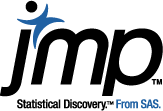

JMP @ MWSUG 2008

MWSUG is pleased to offer extensive JMP-specific content at this year's conference. An entire presentation track will be devoted exclusively to the use of JMP statistical discovery software.
In addition, we are honored this year to welcome Dr. John Sall, Co-founder and Executive Vice President of SAS Institute and leader of the JMP business division. Dr. Sall will give a luncheon keynote address on Monday, October 13, as well as a paper presentation.
| Sponsored by |

|
JMP Presentations
| Speaker | Title (click for abstract) |
| Sall, John | Keynote Luncheon - Putting JMP and SAS® Together |
| Abboud, Nathan | The Effective Billet Heating Method for Ultimate Seamless Tube Size Control |
| Halverson, Ron | Visualizing Business Growth |
| Kane, Vincent | Automated P Charts |
| Kays, Joanne | Using JMP in a Six Sigma Application |
| Gaudard, Marie | Classification of Breast Cancer Cells Using JMP |
| Norris, Roger | Analytical Method Improvement Yields Dramatic Reduction in Variation for Both Analytical an Final Formulation Process |
| Plaumann, Heinz | So, Who's Afraid of Non-Linear Regression? |
| Ramamurthy, Amurthur | Experimental Learning: Use of JMP Journal in Six Sigma |
| Ramsey, Philip J. | Visualization and the Improvement of Anodized Parts Using JMP |
| Sall, John | Modern Dynamic Visualization |
| Weisz, Jon | Data Visualization; a necessary ingredient in making BI effective and realizing analytic excellence |
| Young, Stanley | Chemical Informatics Using JMP |
| Young, Stanley | Consensus NMF: A JMP script for analysis of two-way tables |
JMP Presentation Abstracts
J01. Using JMP in a Six Sigma ApplicationJoanne Kays, Interclarity Research & Consulting, Inc.
JMP software is an important analytical tool in a Six Sigma DMAIC project. JMP allows you to explore and analyze Voice of the Customer data, determine the current state of a process, display where root causes to a problem may exist, analyze whether changes have truly made an improvement to the process, and continuously examine the new process to ensure it stays in control. In this paper, we demonstrate the use of JMP software in a Six Sigma project for diagnostic capital equipment installed in healthcare facilities. We examine both numeric measurement data from the instrument itself as well as transactional data from customer training and service.
J02. Chemical Informatics Using JMPStanley Young, National Institute of Statistical Sciences
Biologists and informatics scientists often wish to view molecules, manage chemical structure data sets, compute molecular properties and conduct statistical analysis of biological results and properties of molecules. For example, screening gives rise to structure-activity data sets and scientists would like to manipulate these data sets for drug discovery. Our idea is to link SAS JMP and its statistical analysis capability with PowerMV, a software system that allows molecular visualization, property computation, and other chemical informatics functions. One very useful capability is to render an attractive 2D drawing of a molecule starting from SMILES, a linear character string representation. Linear strings are a convenient in the JMP data spreadsheet and the strings can be sent to PowerMV for viewing. The benefit of linking JMP and PowerMV is that the non-chemical specialists, biologist and statistician, have access to a powerful working environment for dealing with chemical structures and biological results.
J03. The Effective Billet Heating Method for Ultimate Seamless Tube Size ControlNathan Abboud, The Timken Company
In a competitive seamless tubing market a tight tolerance with a high yield can be achieved by starting with a uniformly heated billet. This paper offers a new method to control furnace temperature to produce billets with a uniform temperature distribution. The result is an optimal control over tube size at no cost.
J04. Analytical Method Improvement Yields Dramatic Reduction in Variation for Both Analytical an Final Formulation ProcessRoger Norris, Eli Lilly and Company
An animal health premix manufactured by Elanco (a subsidiary of Eli Lilly and Company) was subject to structural and common cause variation. The variation was large enough that internal specifications were exceeded creating investigations and reprocessing. A team formed using six sigma tools to improve the process reliability and decrease cost. The dominant source of variation was the analytical method providing information about this manufacturing process.
A series of historical data analyses and designed experiments were used to understand this analytical measurement system better. This presentation will provide an overview of the work done. It will emphasize a design utilizing the JMP™ 5.1 custom design platform that was used to understand complex technical questions where scientist’s experience differed. The result of the controls implemented on the analytical measurement process was a dramatic reduction in variation in both the analytical process and associated manufacturing results.
J05. So, Who's Afraid of Non-Linear Regression?Heinz Plaumann, BASF Corporation
Many technical and business colleagues shy away from maximizing the true value of decision-supporting data due to reluctance to analyze data with the most up-to-date, descriptive and predictive models. Sometimes, this entails the development and fitting of non-linear models.
This paper presents several examples from industry. The first uses SAS-JMP® software to fit models derived to support our work in product development improving performance of professional level bowling balls. This was coupled with extensive use of experimental design and led us to strong structure-property relationships, including the “subjective” evaluation of the end product: Is this really a better bowling ball?
The second example involves analysis of market penetration data. A modified Fisher-Pry model was used to show that our timing in development and market introduction was “just right” for a new family of products for use in automobile interiors. It also helped guide decisions in several cleaning areas.
A final example involves developing understanding in a spray application in agriculture where we applied models to rheological behavior and spray particle size distribution.
J06. Experimental Learning: Use of JMP Journal in Six Sigma Green and Black Belt TrainingAmurthur Ramamurthy, Covance
Six Sigma methodologies have made considerable inroads as continuous improvement tools of choice initially in manufacturing and more recently in service and transactional environments. There is considerable global interest in training professionals on the use and application of Six Sigma tools.
It has long been realized that adult learning is at its best when participants are involved in relevant “hands-on” experiments. Six Sigma training has seen the use of classroom demonstrations ranging from the use of playing cards to simulations and the use of sophisticated experiments to illustrate concepts in factorial designs.
A consistent feedback from belts during training is the need for well-designed case studies, which span the body of knowledge, integrated with the application software such as JMP. This paper presents the features of the JMP journal to accomplish this requirement.
Using features available in the JMP journal, a case study that incorporates statistical tools akin to Six Sigma body of knowledge has been designed. This journal outlines experiments and the expected analysis at each phase. In addition support documentation and provided for reference. The JMP journal acts as a dynamic workbook throughout the course of training where the student records and stores data in addition to analyzing data, saving scripts and documenting presentations.
J07. Modern Dynamic VisualizationJohn Sall, SAS Institute
We have all seen dynamic and interactive graphics on the web, with Ajax, Flash, Silverlight, and other interactive technologies enabling this. Also we have experienced the richness of high-quality fast-moving 3D interactive graphics with each new generation of computer games and the video cards that enable them. We need harness these abilities in the service of business and statistical visualization so we can routinely do dynamic interactive graphs built into the analytic application. Motion and 3D are particularly of interest.
J08. Data Visualization; a necessary ingredient in making BI effective and realizing analytic excellenceJon Weisz, SAS Institute
Effective BI has many ingredients; data cleansing, data integration, data retrieval (query and reporting) and analytics. While these ingredients are important, to be effective analysis results need to motivate others toaction. The best written report has little impact on an organization if it does not motivate action. Motivating action is where data visualization makes a big contribution. This talk will focus on using data visualization to communicate analytic models and data analysis in ways that motivate analytic consumers to action and effective BI.
J09. Consensus NMF: A JMP script for analysis of two-way tablesStanley Young, National Institute of Statistical Sciences
Two-way tables of non-negative (zero and positive numbers) are common. The data tables can be large, e.g. microarray data. There is a need to make simplify and make sense of these complex data sets particularly when using them to make predictions. Non-negative matrix factorization, NMF, can take advantage of correlations among predictors to create ordered sets of predictors; within the ordered sets, statistical testing can be done sequentially, removing the need for correction for multiple testing within the set. However, in the context of micro array analysis, we normally have to run NMF twice, at the observed level and 1/(observed level), to select separately the up- and down-regulated genes. We present Consensus NMF, a computational method for multi-block analysis modeled on Consensus PCA. We turn the one block analysis of micro array data into a two-block problem, where one block uses the observed gene expression levels and the second block uses (observed levels)-1; we then apply Consensus NMF to find, simultaneously, up- and down-regulated genes. This provides a unified approach to the two-sided testing of micro array data. Simulation results demonstrate that power can be substantially increased as compared to standard BH-corrected ANOVA. We also explicate NMF using a whisky taste data set. Computations for this work were done using a complex JMP script.
J10. Visualizing Business GrowthRon Halverson, Halverson Group
As a data mining and visualization tool, JMP tackles some traditional challenges that emerge when mining large, multilevel, longitudinal data sets. JMP is particularly helpful in dealing with non-linear data patterns, complex interrelationships among variables, and trending at multiple levels of analysis/specificity. Non-linear patterns can be difficult to identify using traditional statistics and presented using line or bar charts. JMP bubble charts with trails helped our team visualize 6 years of nonlinear operational and financial performance metrics for thousands of retail outlets spanning 20 markets.
A significant benefit to JMP’s bubble plots is the amount of information that can be conveyed in a single graph. In addition to the traditional x and y axes, data points are displayed by ‘moving bubbles’ with time being the 3rd dimension and bubble size and color representing potential 4th and 5th dimensions. This allows for complicated interrelationships between variables to be visualized in simple, yet impactful ways without overloading clients with information.
With multilevel data sets, JMP bubble plots allow for exploration of complex data at the highest level of analysis with the option of drilling down to increasingly more micro levels within the same graph. This capability is especially beneficial for targeting root causes of patterns and relationships existing at higher levels. It also creates a collective awareness of the discovery path by allowing clients to participate in the exploration journey with experienced analysts.
More traditional statistical procedures such as stepwise regression and partitioning can then be employed in JMP to dig deeper into the root causes of macro and micro patterns. Just as importantly, JMP provides a powerful platform to convey the results of these more complicated statistical analyses in simple, yet impactful ways that have resonated with our clients.
J11. Visualization and the Improvement of Anodized Parts Using JMPPhilip J. Ramsey, North Haven Group
This talk describes how the use of JMP’s visual and analytic capabilities resulted in dramatic yield improvements for an ailing anodizing process. The team members charged with improving this process first used variability charts and other tools to assess both continuous and attribute measurements. They then undertook a visual study of historical data using histograms, scatterplots, and 3D scatterplots to suggest appropriate specification ranges for four key process responses. With this knowledge, the team then designed an experiment to optimize these four responses, using JMP’s Custom Design platform to deal with restrictions on the number of runs. Using the resulting experimental data, and JMP’s Profiler and simulation capabilities, the team was able to simultaneously optimize the four responses and to identify operating windows for key process factors that guaranteed high quality product.
J12. Classification of Breast Cancer Cells Using JMPMarie Gaudard, North Haven Group
Accurate detection of breast cancer is an area of critical importance. This talk utilizes data from the Diagnostic Wisconsin Breast Cancer Database, which were collected in connection with the development of an automated system to classify biopsied cells as malignant or benign based on digital images. Thirty variables are available as potential inputs to the classification process. Using this data, we illustrate the value of a number of JMP’s exploratory and analytic platforms in the development and evaluation of classification models.
J13. Keynote Luncheon - Putting JMP and SAS togetherJohn Sall, SAS Institute
There are unique talents that make JMP a great dynamic visualization front end to SAS, but there are also statistical methods that make JMP and SAS work together much more powerfully than would be possible with either product by itself. One example to be demonstrated is in the field of reliability called degradation analysis. I have data that watches units degrade over time, and the goal is to estimate how long before a certain percentage of the units fail by degrading past the lowest acceptable value. One degradation application would be in determining the shelf life of pharmaceuticals, how long they retain acceptable potency, which could be much more powerfully done by a full-scale degradation model, rather than the stability analysis that is common today. It turns out that doing this involves a fair amount of manipulation with both JMP and SAS, but it is easy to understand once you see it.
J14. Automated P ChartsVincent Kane, Tellabs Operations
The use of a JMP script to provide P charts of product failure rates by both date tested and date manufactured, for products sample tested within finished goods stock. Both P charts, used in conjunction, provide the support engineer with improved insight on part number quality performance to the quality expectancies.
Website maintained by Joshua Horstman.